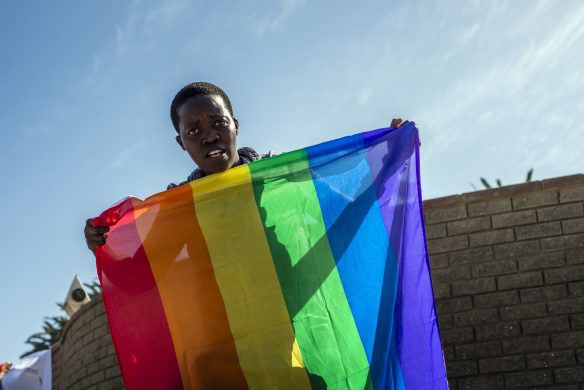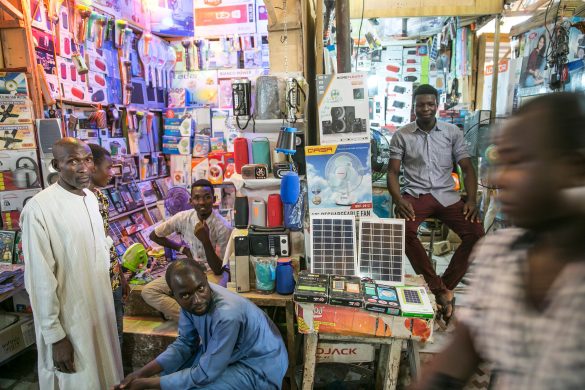President Buhari, 74, a former major-general from the north, returned to Nigeria in mid-August after three months of medical leave in the United Kingdom for an unspecified ailment. It was his second stint of sick leave this year, following a break between January and March.
Soon after the president’s first departure early in the year, speculation over his health filled the streets and media in Nigeria, with some suggesting that he had food poisoning and others claiming that he had died.
“The anxiety was partly due to the secrecy surrounding the president’s medical condition. However, it also relates to the particular role vested in the presidency to uphold the delicate balance between Nigeria’s religious, ethnic and regional groups”, Angerbrandt says.
North-south balance
At the core of the issue is “zoning”, a defining principle for Nigerian politics, which holds that the presidency should rotate between the mainly Christian south and Muslim north, Angerbrandt explains. It is also the practice that a president from the south should have a vice-president from the north, and vice versa.
The issue is particularly sensitive because the previous northern president, Umaru Musa Yar’Adua, died in office in 2010, which prematurely ended the region’s hold on executive power. He was succeeded by his deputy Goodluck Jonathan, a Christian from the south, who went on to win the 2011 election and served another term. Since the end of military rule in 1999, northern politicians have held the presidency for under five years. Should current Vice-President Yemi Osinbajo take over, the north would once again “lose” power to the south.
On his return to Nigeria, in a televised speech President Buhari highlighted the need to hold the country together, saying that he was “distressed” by calls for the dissolution of Nigeria and urged Nigerians to unite.
“Nigeria’s unity is settled and not negotiable”, he said. “We shall not allow irresponsible elements to start trouble.”
The president referred to ethnic tensions – with some calling for a separate state in the south-east known as Biafra – that surfaced during his leave, while the war against militant Islamist group Boko Haram continued in parts of the north.
Informal arrangement
The practice of zoning began during Nigeria’s brief democracy during the second republic in 1979–1983, before the military took power. The major People’s Democratic Party reintroduced the practice in 1999 when Nigeria entered a new period of democracy.
“It became a way for parties to reach out to different groups of the country in order to get votes, acceptance and legitimacy”, Angerbrandt says. While zoning is an informal arrangement, the Nigerian constitution holds that presidential candidates – apart from winning the majority of total votes – need to win at least 25 percent of votes in at least two-thirds of Nigeria’s 36 states. This means that a president needs to secure national support rather than support from just one part of the country. The constitution also contains a so-called “federal character principle”, which states that the cabinet and other national institutions should include representatives from the different states of Nigeria, and that such representatives should be “indigenes” of that state.
Whereas the practice of zoning and the federal character principle promote elite alliances nationally, they tend to politicise ethnicity locally. To become a representative of a certain state, you need to prove that your ancestors were the first people to settle in that area. These claims are often contested by political rivals, as few places Nigeria are ethnically homogeneous and the issue of who “owns” a place has led to violent conflicts in different parts of the country.
Shrinks pool of candidates
Angerbrandt says that although zoning may provide stability and predictability nationally, it is a fragile system, as the turmoil during Buhari’s absence illustrated.
“Things happen that you cannot predict, such as the sick leave of Mr Buhari and, earlier, the death of Mr Yar’Adua in 2010”, Angerbrandt says.
Another downside, Angerbrandt says, is that the zoning model shrinks the pool of presidential candidates, where a person’s regional, ethnic and religious background may potentially overshadow individual merits and ideological vision.
Resilient federation
Angerbrandt says that while the absence of a president is destined to cause uncertainty in Nigeria, transparency and open communication could have avoided much of the recent turmoil.
He also says that although Nigeria is large and multifaceted, the federation has proven resilient, surviving every challenge to the national project.
“Nigeria is actually more integrated than is often portrayed: people have moved around, inter-marriages are common and so on. While there is often talk of a break-up of the country, it is difficult to see how it would be realised.”
President Muhammadu Buhari
In office since 2015, after running as candidate for the opposition grouping All Progressives Congress. He is a retired major-general and was Nigeria’s military ruler from 1984 to 1985, a period remembered for a strict campaign against indiscipline and corruption, and for its human rights abuses. He is a Muslim from northern Nigeria, known as a disciplinarian and with a reputation for honesty.
The “zoning” leadership model
The practice was introduced during Nigeria’s brief democratic period during the second republic (1979–1983).
Between 1983 and 1999 all heads of state came from the north, traditionally a stronghold of the armed forces. The first of them was Maj-Gen Buhari.
An attempt to reintroduce democracy in 1993 failed. The military annulled the elections, which southerner M K O Abiola won, which many in the south saw as the north’s way of keeping power.
After a return to democracy in 1999, the government reintroduced zoning, with the presidency rotating between north and south. In reality, mainly due to the death of northern president Yar’Adua after only two years in office, the south has occupied the presidency longer than the north.














